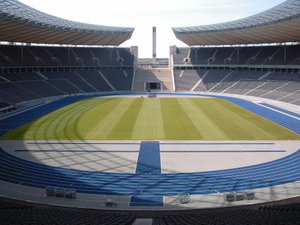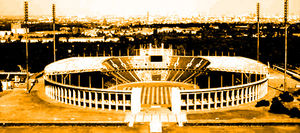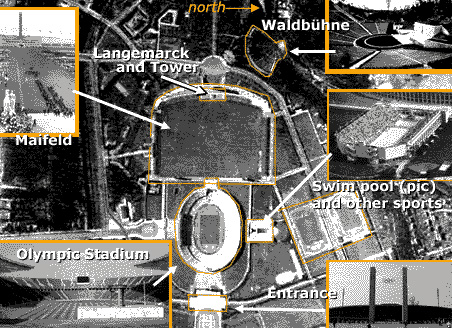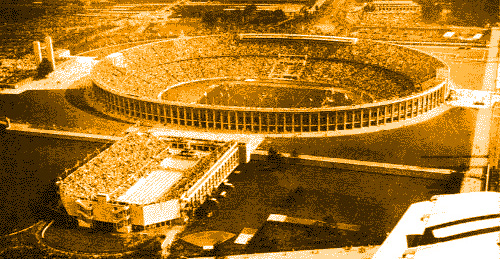Olympic Stadium
Football World Cup 2006 Germany
Olympic Stadium
|
Olympiastadion |
 |
|
Facility Statistics |
| Location |
Olympischer Platz,
Charlottenburg, Berlin, Germany |
| Coordinates |
52°30′52″N, 13°14′29″E |
| Inauguration |
1936 |
| Renovated |
2004 |
| Surface |
Grass |
| Owner/Operator |
WALTER BAU-AG/DYWIDAG, HERTHA BSC, Government of Berlin |
| Initial construction (1934-1936) |
Architect
Werner March |
| Reconfiguration (1974) |
Architect: Friedrich Wilhelm Krahe. Geotechnical engineering:
GuD Consult GmbH. |
| Renovation (2000-2004) |
von Gerkan, Marg und Partner Arcadis Deutschland GmbH
(architect); Krebs und Kiefer Beratende Ingenieure für das
Bauwesen GmbH; Riedel und Gastmeyer
Partnerschaftsgesellschaft; Schlaich, Bergermann und Partner
sbp gmbh. Main contractors: Walter Bau AG and Dywiday. |
| Reconstruction Cost |
EUR
242 million |
| Structural Type |
Horizontal cantilever structure |
| Dimensions |
Circumference: 840 m |
|
Tenants |
Hertha BSC Berlin
Berlin Thunder |
Bundesliga
NFL Europe |
|
Seating Capacity |
|
Football |
76,000 (Germany's second largest arena) |
The Olympiastadion (Olympic Stadium) is a sports
stadium in Berlin. There have been two stadia on the site: the present
facility, and one that was built for the aborted 1916 Summer Olympics. Both
were designed by members of the same family, the first by Otto March and the
second by his son Werner March.
For the
1936 Summer Olympics, and to satisfy his own political plans, Hitler's
National-Socialist (Nazi) Party built the Olympiastadion surrounded by the
massive Olympischer Platz. During World War II these buildings suffered
little damage. After the war, the United Kingdom military occupation used it as its headquarters until
1994.
Aside from its use as an
Olympic stadium, the Olympiastadion has a strong footballing tradition.
Historically, it's the ground of club Hertha BSC of Berlin. It was also used
for 3 matches in the 1974 Football World Cup. It will host six matches in the
2006 Football World Cup and was renovated for that reason. German Cup's
final match is held each year at the Olympiastadion in
Berlin.
The stadium is sometimes seen as controversial, as it was constructed
under the
Third
Reich, and is a concrete, historical manifestation of Adolf Hitler's
personal political dreams in 1936.
 Olympiastadion from the Bell Tower (Glockenturm) before the
renovation, with its noticeable burying in the land.
Olympiastadion from the Bell Tower (Glockenturm) before the
renovation, with its noticeable burying in the land.
1916 to 1934. Deutsches Stadion, old Olympiastadion.
In 1912 during the
1912 Summer Olympics the city of Berlin was designated by the International
Olympic Committee (IOC) to host the 1916 Summer Olympics. Germany's proposed
stadium for this event was to be located in lands located in Charlottenburg,
in Grunewald Forest, to the west of Berlin -- thus the stadium was also
known as Grunewaldstadion. A horse racing-course already existed there which
belonged to the Berliner Rennverein, and even today the old ticket booths
survive, on Jesse-Owens-Allee street .) The government of Germany decided to
keep the nearby Grunewald forest as it was, as well as the exisiting built
environment. With all this in mind they hired the same architect who
originally had built the "Rennverein", Otto March.
March decided to bury the stadium in the ground ("Erdstadion", in
German). The project became the biggest sports stadium in the world to date
with a capacity of 40,000 spectators.
Eventually, however, the Olympic Games of 1916 were cancelled due to the
First World War. After this conflict, a school was founded in the vicinity
of the Stadium, dedicated to the instruction of physical education
professors and to do sports research. From 1926 to 1929, Otto March's sons (Werner and
Walter) were assigned to build an annex for these institutions: the
"Deutsches Sportforum" (German Sportforum), though the construction was
intermittent because the project had little financial support.
1936. Olympischer Platz, sportfield of the Reich.
In 1931 the International Olympic Committee made Berlin the host city of
the 11th
Summer Olympics.
Originally, the German government decided merely to restore the earlier
Olympiastadion (German Stadium) of 1916, with
Werner March being again ordered to do this.
When the
Nazis came to power in Germany (1933), they decided to use the Olympic Games
for certain propaganda purposes. With these plans in mind, Hitler ordered
the construction of a great sports complex in Grunewald named the "Olympischer
Platz," with a totally new Olympiastadion. Architect Werner March remained
in charge of the project, assisted by his brother Walter March.
Construction took place from 1934 to 1936. When the Olympischer Platz was
finished, it was 132 hectares (326 acres) and had a symmetrical layout. It
consisted of (east to west): Olympiastadion, Maifeld (Mayfield) (capacity of
500,000) and Waldbühne amphitheater (capacity of 25,000), in addition to 150
buildings for different sports such as swimming, equestrian events, and
field hockey).

Olympiastadion
Over the original Deutsches Stadion, Werner March built the new
Olympiastadion, once again buried 12 meters underground. The lower half of
the structure is buried.
The capacity of the Olympiastadion reached 110,000 spectators. It also
possessed a VIP stand for Adolf Hitler and his political associates. At its
end, aligned with the symmetrically-designed layout of the buildings of the
Olympischer Platz and toward the Maifeld, was the "Marathontor" (Marathon
Arch) with a big receptacle for the Olympic Flame.
Maifeld
Maifeld (Mayfield) was created as a huge lawn (112,000 square meters, 28
acres) for gymnastic demonstrations, specifically annual May Day
celebrations by Hitler's government.
Maifeld was surrounded by land elevations of 19 meters (62 feet).
Although the Olympiastadion (at the east) was only 17 meters (55 feet) high.
The total capacity was 250,000 people, with 60,000 in the large stands
that extended at the west end. Also located there were the
Langemarck-Halle (below) and the Glockenturm (rising high).
The walls were built with sturdy stone from the area of the Lower Alps,
and also feature equine sculptures (work of
Josef Wackerle).
During the 1936 Olympics the Maifeld was used for polo events and
several allegorical Nazi gymnastic demonstrations.
Glockenturm, the Bell Tower
This tower crowned the western end of the Reichs Sportfield planted amid
the tiers of the Maifeld stands. It was very high: 77 meters (247 feet).
From its peak could be observed the whole city of Berlin. During the games
it was used as observation post by administrators and police officials,
doctors and the media.
In the tower as well was the
Olympic Bell. On its surface, the Nazi regime engraved the five Olympic
Rings, a motto ("I summon the youth of the world Olympic Games 1936"), the
Brandenburg Gate and an Eagle.
[1]
The Langemarck-Halle
Consisted of huge halls built under the stands of the Maifeld. Pillars
were raised on which hung flags and shields commemorating all the forces
that participated in a battle fought in Langemarck (West Flanders, Belgium)
on November 10, 1914, during the First World War.
Waldbühne, the Forest Theatre
The Waldbühne was built by using the glacial river banks of the Berlín
Urstromtal. Reproduction of the old theater of Epidaurus (3rd century BC).
The theater was then named "Dietrich-Eckart-Bühne" in homage to Dietrich
Eckart.
Seating for 22,000 spectators goes down to a depth of 30 meters (97
feet); in the middle section was once Adolf Hitler's box. The surroundings
were decorated with statues by
Adolf Wamper.
During the Olympics
gymnastics competitions and a myriad of cultural programs were staged in
the Waldbühne.
Berlin,
1936 Summer Olympics.
In August 1 of 1936 the Olympics were officially inaugurated by
Chancellor Adolf Hitler, and the Olympic Flame was lit by the athlete Fritz
Schilgen.
While the Olympic Flame had been used for the first time in Amsterdam
1928, in Berlin 1936 a marathon-like tour of the Olympic Torch was
introduced, from Olympia in Greece, crossing six frontiers with a journey of
3000 km to Berlin, through
Greece, Bulgaria, Yugoslavia, Hungary, Czechoslovakia, Austria and Germany.
The original idea of this Olympic torch relay belonged to Carl Diem,
who was a notorious political advisor in Germany specializing in Olympic
affairs.
Four million tickets were sold for all the events of the 1936 Summer
Olympics. This was also the first Olympics with television transmission (25
giant screens were scattered all over Berlin) and radio transmissions in 28
languages (with 20 radio vans and 300
microphones).
Among the sport competitions one of the most memorable events was the
performance of the
African-American track and field athlete Jesse Owens, representating the
United States of America. Owens was awarded the gold medal in 4 categories:
100-meter dash, 200-meter dash, long jump and 4X100 meter relays.

1939 to 1945.
Second World War.
The Olympiastadion was one of the few buildings that survived not just
recognizable, but almost untouched after the Second World War. It only
suffered impacts of
machine gun shots.
The most notorious battle around the Olympiastadion was in April 1945
when the Russian army fought to capture it. This was when the great final
battle of the Second World War, with the total invasion of Berlin as the
Allies' target.
By these weeks, in one of his last moves Adolf Hitler had called for the
"Volkssturm" (Popular Storm): the recruitment of all German males from
16 to 60 years old in order to add six million more combatants. This
resulted in an ill-prepared army of what could almost be called partisans
(though they were not this by definition because they wore a military
armlet). One of the components of the Volkssturm was the Hitler Youth, led
politically by Carl Diem (one of Hitler's sports advisors) and Arthur Axmann.
Then, when the
Soviet army
had already taken the Olympitzer Platz and knowing the terrain because his
political activities, Diem called for the reconquest of the facilities
offering them to Hitler's honor
[2]. Eventually, the Hitler Youth suffered 2000 deaths in this futile
attempt.
The only part of the Olympischer Platz that was destroyed was the
Glockenturm Tower. The Third Reich used this structure to store archives
(such as films). The Soviet troops set on fire all its contents turning the
tower into a makeshift chimney. The structure emerged from the fire severely
damaged and weakened. In 1947 British engineers demolished the tower once
and for all. The Olympic Bell (which had survived the fire and remained in
its place in the tower), fell 77 meters and cracked. In 1956 the bell was
rescued in order to be used as a practice target for shooting with anti-tank
ammunition and was unable to sound since then. The cracked bell survives to
this day.[3]
1945 to 1994. Occupied Berlin
After the war the Olympischer Platz was used as headquarters by the
military ocupation forces of the
UK.
The British forces settled in the places built by the March siblings
(back in the 1920s), which the Third Reich had used for official sport
organisms (like the
Reichs Academy of Physical Training and the House of German Sports).
Soon the Occupation started a careful reconstruction of the general
facilities.
Since then, until 1994, British forces held an annual celebration of
Sovereign Day in the Maifeld with thousands of spectators from Berlin
present.
During these years in the Olympiastadion were played Bundesliga
(football) matches with the Hertha Berlin as local team. In the Maifeld,
also several competitions of football, rugby and polo were
staged.
In the summers the Waldbühne resumed its concerts of classical music, as
well the projection of movies. The theatre was also used as an improvised
ring for boxing matches.
The restoration of the "Glockenturm" was carried out from 1960 to 1962,
once again by the architect Werner March. The new tower became an important
tourist destination offering a magnificent panorama of Berlin, Spandau, the
Havel Valley, Potsdam, Nauen, and Henningsdorf.
Hertha Berlin
In 1963 the
Bundesliga was formed, and Hertha participated by direct invitation, leaving
its old stadium (called the "Plumpe") to use the Olympiastadion. In August
24 it played the first local match against the FC Nuremberg, ending in a tie (1:1).
But in 1965 the German
Football Association DFB found Hertha guilty of bribery and relegated it to
the lower divisions (Regional Leagues). Hertha had illegally bribed several
fooball players in an attempt to add them to the team, following their lack
of interest to play in Berlin because of the construction of the Berlin Wall
(1963
In 1968 Hertha returned to the first division, and to the Olympiastadion,
and in 1971 sold its old "Plumpe".
The second half of 1970s was quite successful for the Hertha Berlin. In
1979 were held the semifinals of the UEFA Cup, but it was defeated by the
Red Star of Belgrade. Hertha reached the finals of the German FA Cup twice (1977 & 1979).
In 1980s Hertha had a declining role in the Bundesliga, and fell to the
Regional Leagues in 1986, although it later recovered reaching the Second
Division (1988-1989).
With the demolition of the
Berlin Wall in November, 1989, there arose a spontaneous feeling of sympathy
between Hertha and the club FC Union from Eastern Berlin, which culminated in a friendly match at
the Olympiastadion with 50.000 spectators (January 27, 1990).
In 1990 Hertha returned to the first division, although it fell again to
the Second League from 1991 until 1997.
Since 1997 the club has improved greatly, climbing up the Bundesliga
table and qualifying for the UEFA Champions League, with matches against top
European teams like Chelsea and A.C. Milan increasing the international prestige of the club.
Football World Cup 1974
Some matches of Group A (West Germany, Chile, East Germany and Australia)
of the FIFA World Cup ´74 were played in the Olympiastadion.
| FIFA Day |
Match |
Round |
Team 1 |
|
Team 2 |
Destination |
|
June
14 |
|
Group A |
 East Germany 1
East Germany 1 |
Vs. |
 Chile 0
Chile 0 |
Second Round |
|
June
18 |
|
Group A |
 West Germany 1
West Germany 1 |
Vs. |
 Chile 1
Chile 1 |
Second Round |
|
June
22 |
|
Group A |
 Australia 0
Australia 0 |
Vs. |
 Chile 0
Chile 0 |
Second Round |
| Team |
Pts |
Pld |
W |
D |
L |
GF |
GA |
GD |
 East Germany
East Germany |
5 |
3 |
2 |
1 |
0 |
4 |
1 |
3 |
 West Germany
West Germany |
4 |
3 |
2 |
0 |
1 |
4 |
1 |
3 |
 Chile
Chile |
2 |
3 |
0 |
2 |
1 |
1 |
2 |
-1 |
 Australia
Australia |
1 |
3 |
0 |
1 |
2 |
0 |
5 |
-5 |
The host West German team eventually became World Cup Champion for
1974'.
1994 to 2005
In 1998 a debate was unleashed among Berlin public, concerning the
destiny of the Olympiastadion in light of the historical legacy it
represented for Germany.
For example some wanted to tear the stadium down and build a new one from
scratch, while others favoured letting it slowly crumble "like the Coliseum
in Rome".
[4]
Finally it was decided to renovate the Olympiastadion. Also
FIFA appointed
it as one of the venues of the
Football World Cup 2006. The State of Berlin finally hired a company,
WALTER BAU-AG together with DYWIDAG that contributed for franchise award
with €45 million of the works, which after the remodelling took charge of
the operation of the facilities together with Hertha BSC and the own Government of Berlin.
In July 3 of 2000, began the works of renovation and amplification. With
a ceremony presided by the
Chancellor Gerhard Schröder. Accompanied by Eberhard Diepgen (Berlin Mayor),
Franz Beckenbauer and Prof. Dr. Ignaz Walter.
Technical details
70,000 cubic metres (2.5 million cu. ft.) of concrete
and 20,000 cubic metres (700,000 cu. ft.) of pre-cast reinforced concrete
elements were used. 12,000 cubic metres (424,000 cu. ft.) of concrete was
demolished and removed and 30,000 cubic metres (1.1 million cu. ft.) of
natural
stone was refurbished.
The roof was extended, to cover a total of 37,000 square metres. With 20
roof-supporting columns carrying a weight of 3,500 tones of steel.
With the intention to create a more intimate atmosphere for football
games the
playing field was lowered (even more) by 2.65 metres (9 feet); approximately
90,000 cubic metres (3.2 million cu. ft.) of sand was excavated. The lower
tier of seating in the stadium was demolished and rebuilt at a completely
different angle of inclination.
The conservation factor of the Olympiastadion as a historical monument
was also considered, especially with respect to the preservation of the
natural stone blocks. Deserving a separate comment the critics that caused
the change of the colour of the carpet for
the athletics around the game field from red to blue.
The renovation
 Air photograph of the Berlin Olympiastadium and the Olympischer
Platz after the renovation.
Air photograph of the Berlin Olympiastadium and the Olympischer
Platz after the renovation.
Among 31th July 2004 to 1st August 2004 were carried out the inauguration
celebrations of the new Olympiastadion. On that Saturday the party began
with the performance of the pop-stars Pink, Nena (99 Red Ballons) and of
Daniel Barenboim. It culminated at night with the opening ceremony.
On the second day friendly matches were played with different categories
of the club Hertha BSC and other visitor teams. And on September 8 2004
Brazil confronted Germany.
The new Olympiastadion of Berlin resulted with capacity of 76,000 seats,
which made it the second stadium in Germany (behind the Westfalenstadion).
The roof rises 68 meters over the seats and is made up of transparent
panels that assure great brightness. With a picturesque detail: the western
portion (on the
Marathon Arch) is open to reveal the "Glockenturm" to the assistants.
Also the Olympiastadion was equipped with the latest technology in
artificial illumination and sound equipment. And it now has 113 VIP stands,
a set of restaurants and two underground garages (for 630 cars).
The total cost of the remodeling and amplification is generally qualified
as "not expensive": EUR 242 million.
Current Usage
Hertha BSC Berlin, plays it's DFB-Bundesliga matches. Historical
local team.
German Cup's (official German title: "DFB-Pokal") final match is held at
the Olympiastadion yearly.
Ladies DBF-Cup, since 1985.
ISTAF, annualy as part of the Golden League in athletics.
Berlin Thunder, NFL Europe (American Football) club.
FIFA World Cup 2006
Scheduled Matches
| FIFA Day |
Match |
Round |
Team 1 |
|
Team 2 |
Destination |
|
June
13 Tue |
11 |
Group matches |
 Brazil
Brazil |
Vs. |
 Croatia
Croatia |
Rounds of Sixteen |
|
June
15 Thu |
20 |
Group matches |
 Sweden
Sweden |
Vs. |
 Paraguay
Paraguay |
Rounds of Sixteen |
|
June
20 Tue |
33 |
Group matches |
 Ecuador
Ecuador |
Vs. |
 Germany
Germany |
Rounds of Sixteen |
|
June
23 Fri |
48 |
Group matches |
 Ukraine
Ukraine |
Vs. |
 Tunisia
Tunisia |
Rounds of Sixteen |
|
June
30 Fri |
57 |
Quarter finals |
W49 (WA-RB) |
Vs. |
W50 (WC-RD) |
Semi Finals (61, Dortmund) |
|
July 9
Sun |
64 |
Final |
W61 |
Vs. |
W62 |
World Champion |
Political considerations.
The Olympiastadion was designated to play the
final match of the
FIFA World Cup 2006. And this will take place exactly 70 years after the
1936 Summer Olympics.
Peter Steinhorst, chief technician on the project, said to the BBC: "Whenever
you enter, you will still know this was the site of the 1936 Games. You will
pass all the old Nazi sculptures".
[5]
"The history is there, the totality of the buildings is there. The whole
Nazi landscape has not disappeared", added the sports sociologist
Guenter Gebauer. "There are towers like in a fortress, and people who
come will always ask where the Fuehrer sat.".
[6]
The Interior Germany's Minister
Otto Schilly, who attended the opening party, concluded: "The stadium
recalls the dark elements present in its creation. But in 2006 the world
will look upon to modern, democratic, and open Germany".
[7]
Trivia
- In January 9 2002, workers of the construction found a
bomb
remaining under a seat from the Second World War. It was detonated
outside of the Olympiastadion by the police of Berlin.
[8]
- One of the streets in the surroundings takes Jesse Owens' name.
- Between 1951 to 2005, the Olympischer Platz had a giant antenna
transmitting for all the portable radios in Berlin.
- The Olympiastadion had a role in Contact, the popular science
fiction history by
Carl Sagan. Both in the novel and the film, the extraterrestrial
civilization intercepted the Nazi televised transmission of the opening
ceremony of the 1936 Summer Olympics, with the speech (and the nazi
harangue in the movie) of Adolf Hitler. And later the extraterrestrials
sent it back towards the Earth, initiating a dialogue.
External links
-
Official Olympiastadion Site: Partially under construction. Scarce
information, though it allows to reserve tickets.
-
The Nazi Olympics: Complete historical enumeration of the Nazi
projects (in the 1930s). Some of the images few times seen before. As
example, seems that after the successful 1936 Summer Olympics Adolf
Hitler dreamt with creating a massive stadium in Germany to 400,000
spectators. Where would take place all the other Olympic Games.
-
Picture galleries: An illustrative walk along the facilities of the
Olympischer Platz.
-
Photos of the stadium taken in 1989: Interesting details,
particularly of the statues of the Nazi era.
-
Site of HERTA BSC football club: Very informative site.
Home | Up | Olympic Stadium | Signal Iduna Park | Commerzbank-Arena | Veltins-Arena | AOL Arena | AWD-Arena | Fritz Walter Stadion | RheinEnergieStadion | Zentralstadion | Allianz Arena | Frankenstadion | Gottlieb-Daimler-Stadion
Football World Cup 2006, made by MultiMedia | Free content and software
This guide is licensed under the GNU
Free Documentation License. It uses material from the Wikipedia.
|




